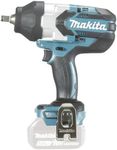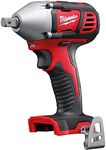Buying Guide for the Best Cordless Impact Wrenches
When choosing a cordless impact wrench, it's important to consider the specific tasks you plan to tackle. These tools are essential for loosening and tightening bolts and nuts, especially in automotive and construction work. The right model for you will depend on factors like the power you need, the size and weight of the tool, and how long you need it to run on a single charge. Understanding the key specifications will help you make an informed decision that matches your needs.TorqueTorque is the rotational force that the impact wrench can apply. It's crucial because it determines the tool's ability to loosen or tighten bolts and nuts. Torque is measured in foot-pounds (ft-lbs) or Newton-meters (Nm). For light tasks, such as assembling furniture or working on small engines, a lower torque (around 100-200 ft-lbs) is sufficient. For automotive work or heavy-duty construction, you'll need higher torque (300 ft-lbs and above). Consider the toughest job you expect to do and choose a torque rating that meets or exceeds that requirement.
Battery VoltageBattery voltage indicates the power potential of the cordless impact wrench. Higher voltage typically means more power and longer run time. Common voltages range from 12V to 20V. For light-duty tasks, a 12V model might be adequate, while 18V or 20V models are better suited for more demanding jobs. Think about the intensity and duration of your typical tasks to decide on the right voltage for you.
Battery CapacityBattery capacity, measured in ampere-hours (Ah), tells you how long the battery can last on a single charge. A higher Ah rating means longer run time. If you plan to use the wrench for extended periods or on multiple projects without frequent recharging, look for a battery with a higher capacity, such as 4.0 Ah or more. For occasional use, a lower capacity might suffice.
SpeedSpeed in impact wrenches is measured in revolutions per minute (RPM) and impacts per minute (IPM). Higher speeds allow for faster operation, which is beneficial for time-sensitive tasks. However, more speed can mean less control. For precision work, a model with variable speed settings is ideal, allowing you to adjust the speed according to the task at hand. Consider the balance between speed and control based on your typical projects.
Weight and ErgonomicsThe weight and ergonomics of a cordless impact wrench affect user comfort and fatigue, especially during prolonged use. Lighter models are easier to handle and reduce strain, but they might offer less power. Ergonomic designs with comfortable grips can enhance control and reduce fatigue. If you plan to use the tool frequently or for extended periods, prioritize models that offer a good balance of weight and comfort.
Anvil SizeThe anvil size of an impact wrench determines the size of sockets it can accommodate. Common sizes are 1/4-inch, 3/8-inch, and 1/2-inch. Smaller anvils are suitable for lighter tasks and tighter spaces, while larger anvils are better for heavy-duty applications. Consider the types of projects you will be working on and choose an anvil size that matches the socket sizes you will most frequently use.

















